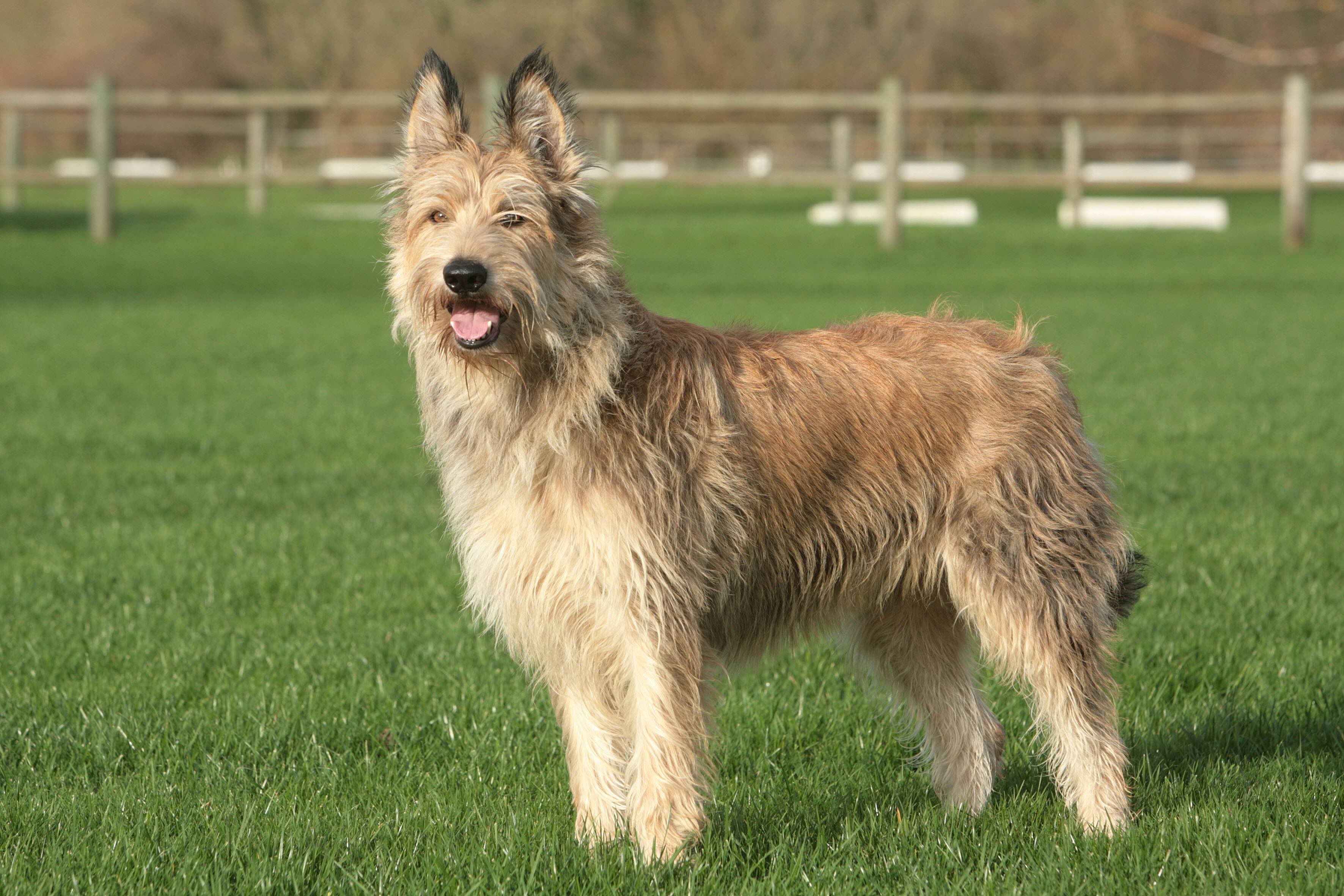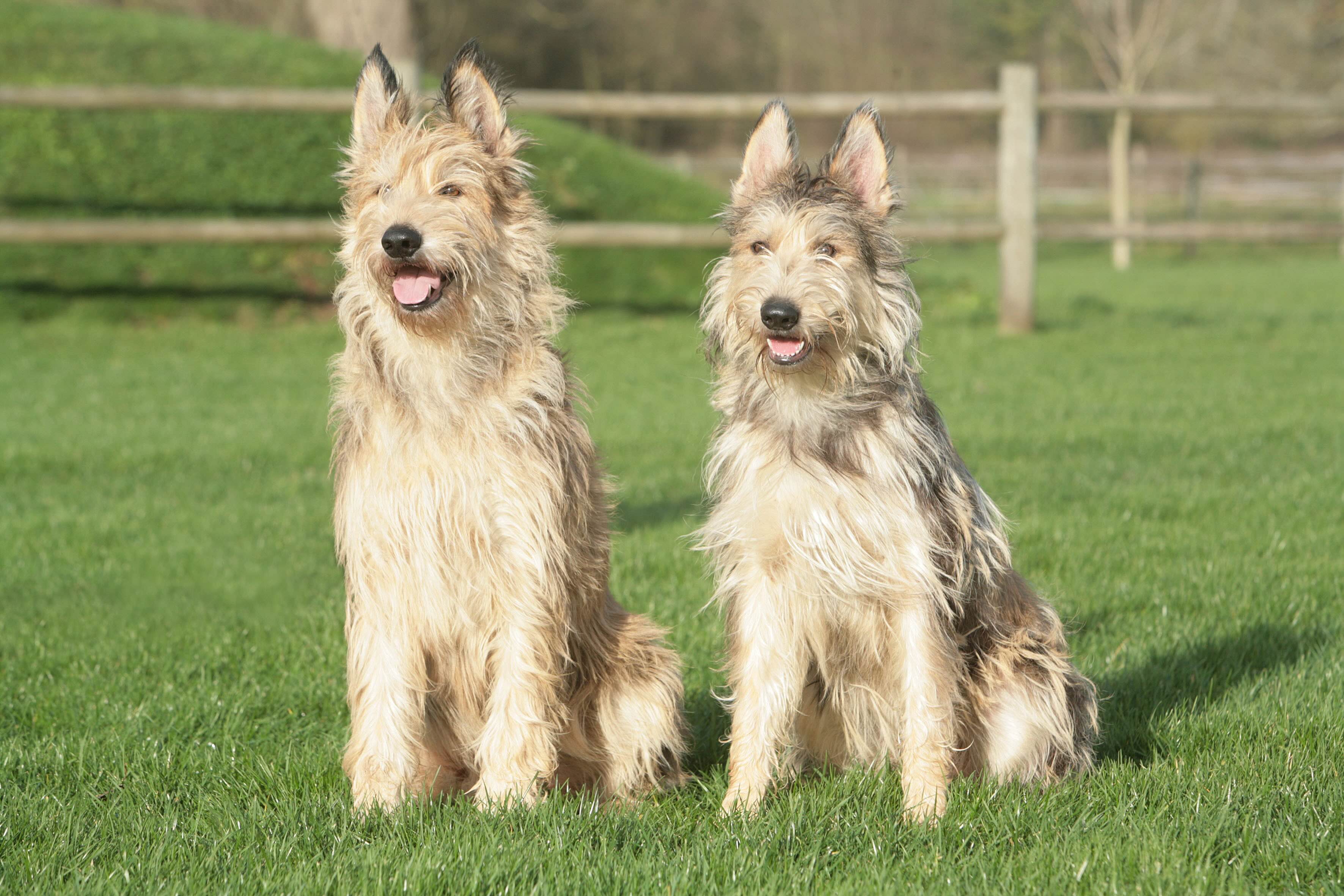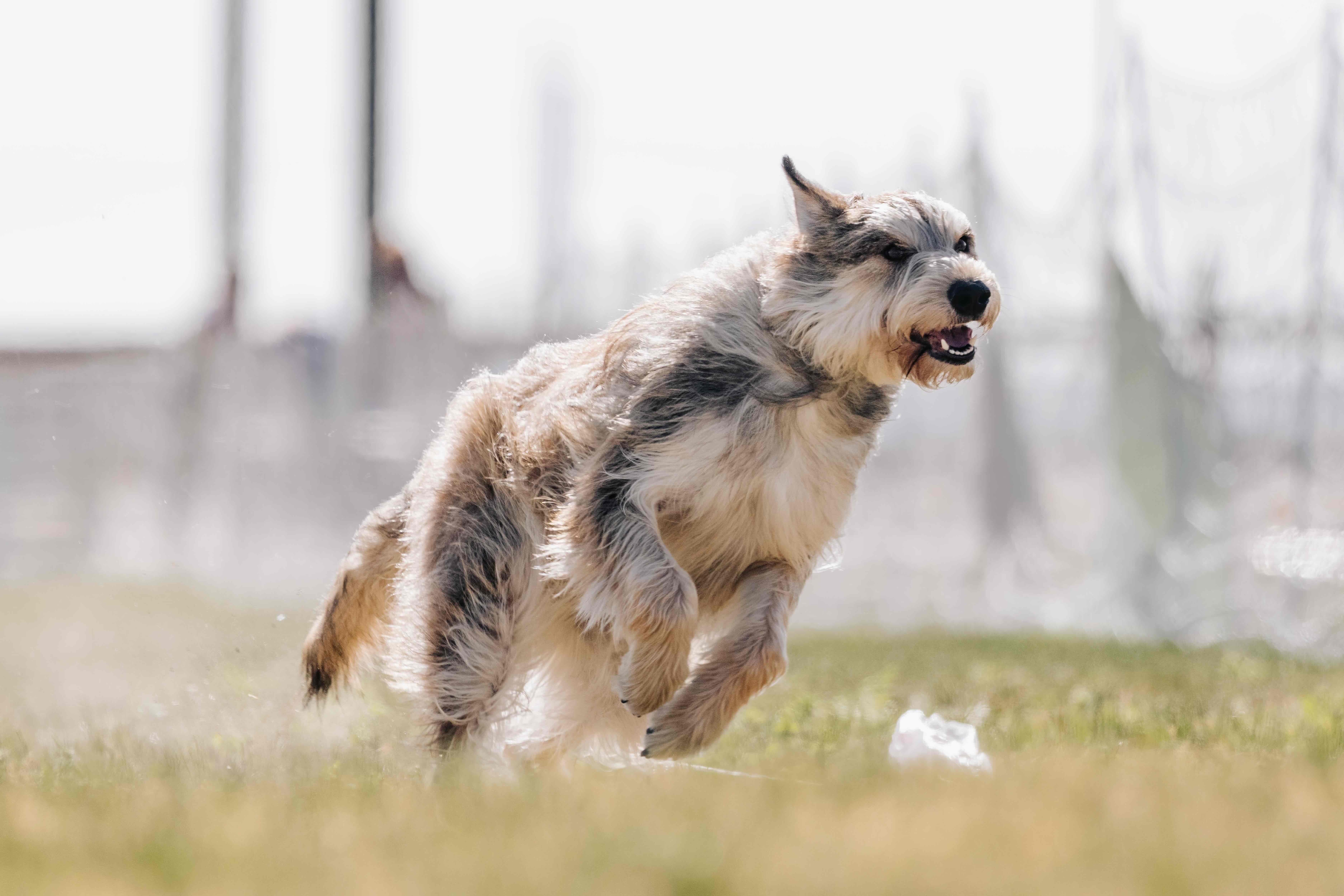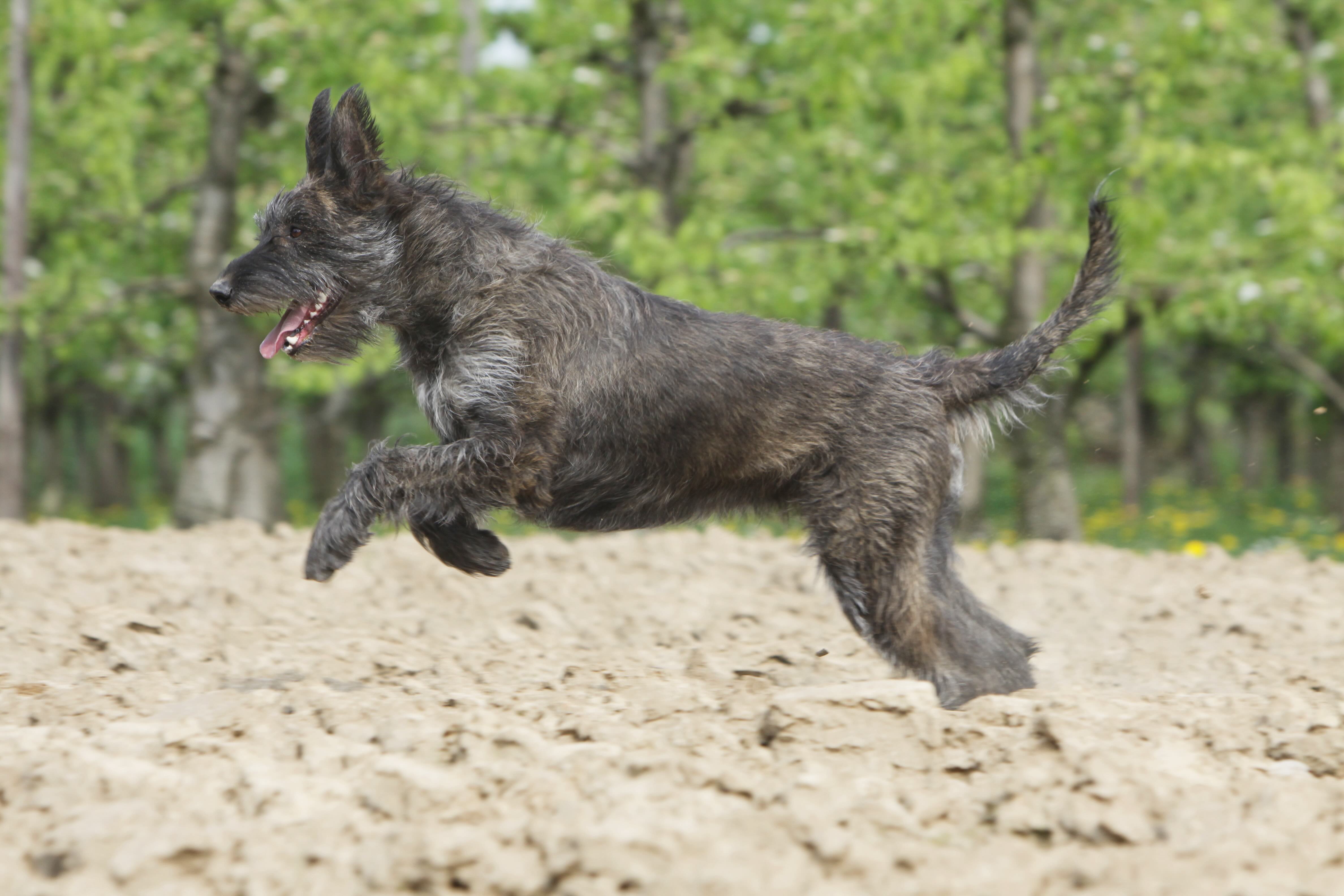Berger Picard
Adobe Stock/tmart_foto
The Berger Picard (pronounced bare-ZHAY pee-CARR) is a French herding dog. (Berger is French for shepherd and Picard refers to the Picardy region of France.) You may hear them referred to simply as Picards or as Picardy Shepherds.
Bred to herd sheep and cattle, Berger Picard dogs are built for the job. Their harsh, weatherproof fur repels dirt and needs little upkeep. Their long legs, muscular body, and vast energy help them meet the physical demands of their job. And their high level of intelligence and sensitivity are key qualities for working with both people and farm animals.
And yet, these lovably scruffy, sporty herding dogs can also trade farms and fields for family life. Your Berger Picard will, however, still need a job and close companionship to thrive.
Caring for a Berger Picard
Berger Picards were bred for work, and they don’t lose their instincts as companion animals. Here’s what this means for prospective families:
-
Berger Picards need a job, but this doesn’t mean you need to give them a farm or livestock. You will, however, need to provide daily exercise. As long as they have time to be active outside, Picards are typically patient and calm dogs indoors.
-
The Berger Picard Club of America (BPCA) says Berger Picards develop close relationships with the main person in their life. Socialization can help them be more accepting of other people and to rely less on their one person. Regardless, you can expect your Picard to need lots of attention.
-
Berger Picards have a high prey drive. While this instinct is harnessed for herding, the BPCA notes that Picards will also “chase whatever moves,” including squirrels, rabbits, deer, and cats. Bergers may not be the best choice for homes that have (or would like to have) other small pets.
-
The Picard’s high prey drive means that all outdoor exercise should also occur either on a leash or within a securely fenced area.
Despite their rustic appearance and lifestyle, the BPCA says Picards can adapt well to city life, provided their pet parent is able to provide exercise and companionship.
Like most working dogs, Berger Picards’ grooming needs are low. Their characteristic wiry coat needs only an occasional brushing most of the year, and more consistent attention during spring and summer to control the shedding of their undercoat.
Berger Picard Health Issues

Berger Picards are generally healthy dogs with an average lifespan of 12–13 years. However, like all breeds, they are prone to certain health conditions.
Progressive Retinal Atrophy
Progressive retinal atrophy (PRA) is an umbrella term for a family of eye disorders in which the rods and cones of the retina break down. There is no cure for PRA, and the condition eventually leads to blindness.
Signs of PRA include:
-
Reluctance to enter dark spaces
-
Clumsiness (especially in dark spaces)
-
Dilated pupils that constrict slowly in response to light
-
Eyes that are more reflective in the dark
Dilated Cardiomyopathy
Dilated cardiomyopathy (DCM) is a disease in which the heart muscle becomes larger and stretches out. This weakens the muscle’s ability to pump blood.
Signs of DCM include:
-
Rapid breathing
-
Restlessness
-
Labored breathing
-
Exercise intolerance
-
Swollen belly
There’s no cure for DCM, but the disease is typically managed with medications that decrease the heart’s workload, improve the heart’s efficiency, and remove fluid from the lungs.
Hypothyroidism
Hypothyroidism is a disease in which the thyroid gland doesn’t produce enough thyroid hormones, which serve an important function in metabolism. This affects how most organ systems function in the body. Treatment requires lifelong hormone replacement therapy with oral medication.
Hypothyroidism tends to affect medium- to large-sized dogs like Berger Picards, and it’s most common in dogs 4–10 years old. Signs of hypothyroidism include:
- Unexplained weight gain
- Lethargy
- Inability to stay warm
- Mental dullness
- Recurring skin infections and ear infections
Hip Dysplasia
Hip dysplasia is a condition in which the hip joint doesn’t develop properly, causing looseness that leads to osteoarthritis in dogs. Mild cases are treated with interventions like physical therapy and anti-inflammatory medications, but severe cases may require surgery.
Common signs of hip dysplasia include:
-
Limping
-
Reluctance to get up or jump
-
Shifting of weight to front legs
-
Loss of muscle mass in back legs
-
Hip pain
What To Feed a Berger Picard

No two Berger Picard dogs are exactly alike, so it’s important to partner with your veterinarian to choose the best dog food and feeding plan for your pet.
Your vet can recommend a food that meets Association of American Feed Control Officials (AAFCO) standards and is nutritionally complete for your pet’s life stage (puppy, adult, or senior), size, lifestyle, and health.
How To Feed a Berger Picard
Most adult Berger Picards do well eating two meals a day: once in the morning and again in the evening. Berger Picard puppies have a higher metabolism and may need three feedings per day (morning, midday, evening).
Your veterinarian can help you create the best feeding schedule for your dog as they grow.
How Much Should You Feed a Berger Picard?
The label on your dog’s food packaging includes a feeding guide to give you a rough idea of how much to feed your dog. While that’s helpful, your veterinarian can offer more accurate guidance. A vet can recommend food and portion sizes depending on your dog’s specific information, including age, weight, body condition score, lifestyle, and health needs.
Include dog treats in your daily calorie count. But remember: Treats should never make up more than 10% of your dog's daily calories.
Nutritional Tips for Berger Picards
If your Berger Picard is eating a complete and balanced dog food that’s AAFCO-compliant, they may not need supplementation.
However, nutritional dog supplements are sometimes used to treat or prevent certain health conditions. For example, your vet may recommend joint supplements if your Berger Picard is at risk of hip dysplasia.
Talk to your veterinarian before adding supplements to your dog’s diet.
Behavior and Training Tips for Berger Picards
Berger Picard Personality and Temperament

The Berger Picard breed standard describes these dogs as being “lively and alert, observant, confident, [and] even-tempered.” Such traits served them well as herders of sheep and cattle, but they can also translate nicely to house pet life—especially in active families who can provide them with daily exercise.
Though they’re described as one-person dogs, Berger Picards can get along with people of all ages. They do need time to warm up to strangers, and due to the Picard’s high prey drive, they may not be a great choice for homes with smaller pets.
Berger Picard Behavior
Bored and lonely Berger Picard dogs with energy to burn will be more likely to display unwanted behaviors, like rowdiness. Daily exercise and close companionship are musts.
Berger Picard Training
Because this breed can be reserved when meeting new people, it’s important to begin socializing your Berger Picard puppy as soon as they come home. Safely exposing them to new people, animals, situations, and environments during their first 16 weeks of life will help them grow into confident and comfortable dogs.
Talk to your Berger Picard breeder about how they have approached socialization, and ask your veterinarian to suggest activities that are safe for your pet’s age.
Berger Picards are highly intelligent dogs, but the BPCA notes that they can also be a bit willful and deeply sensitive. Positive, rewards-based training is the best way to harness their independent spirit while preserving the human-animal bond.
The club adds that as natural problem solvers, Berger Picards aren’t fans of repetitive training, so it’s best to keep sessions short and engaging.
Fun Activities for Berger Picards
-
Skills training
-
Tracking
Berger Picard Grooming Guide

The Berger Picard’s famously shaggy coat, which can be either fawn or brindle in color, is famously easy to care for.
Skin Care
According to the BPCA, the Berger Picard is a low-odor breed with a low-oil coat that repels dirt. Thus, bathing is rarely necessary. Talk to your veterinarian about how often you should bathe your Berger Picard.
Coat Care
The Berger Picard’s double coat isn’t prone to matting, so brushing is just an occasional need most of the time. However, you may need to increase your efforts in the spring and summer when they shed their undercoat. Trimming their coat is not recommended.
Eye Care
Berger Picards are prone to developing progressive retinal atrophy. Contact your veterinarian if you notice the signs of PRA, or other signs of disease like redness and discharge.
Ear Care
The Berger Picard’s ears stand characteristically erect, so they aren’t as prone to ear infections as floppy-eared dogs. Still, talk to your veterinary team about how and how often you should clean your dog’s ears, as well as which ear-cleaning products to use.
Call your vet if you notice signs of an ear infection, such as redness, odor, pain, itchiness, or head shaking. If your dog gets ear infections frequently, this may be a sign of hypothyroidism.
Considerations for Pet Parents
Here are some questions to consider before adding a Berger Picard to your family:
-
Am I home enough to meet the needs of a dog that forms a close attachment to one person?
-
Do I have the time and energy to exercise an active, energetic dog every day?
-
Can I keep a dog with a high prey drive on a leash or within securely fenced areas when outdoors?
-
Do I have the skills and patience to provide extensive socialization and lifelong training using positive reinforcement?
-
Am I financially prepared to provide veterinary care?
-
Can I provide a dog with a loving home for their lifetime, which could be 13 years or more?
If you can answer these questions with an enthusiastic “Yes!” you may be ready to parent a Berger Picard.
Berger Picard FAQs
Is a Berger Picard a good family dog?
The Berger Picard is a smart, sensitive, and scruffy dog that was bred to herd sheep and cattle. They will do best with a family who can provide them with copious amounts of both exercise and companionship.
Are Berger Picards cuddly?
Berger Picards aren’t typically described as cuddly, but they are highly attached to their families. And while they have seemingly endless energy during play times, they are content to relax with their people when indoors.
What is the life expectancy of a Berger Picard?
Berger Picards have an average lifespan of 12–13 years.
